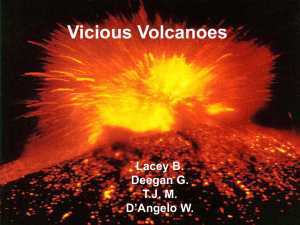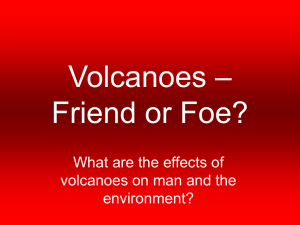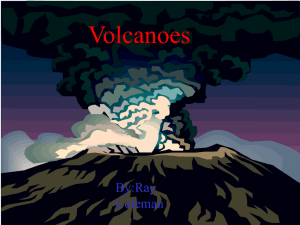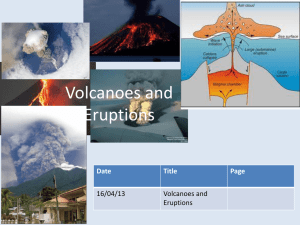Volcanoes
advertisement
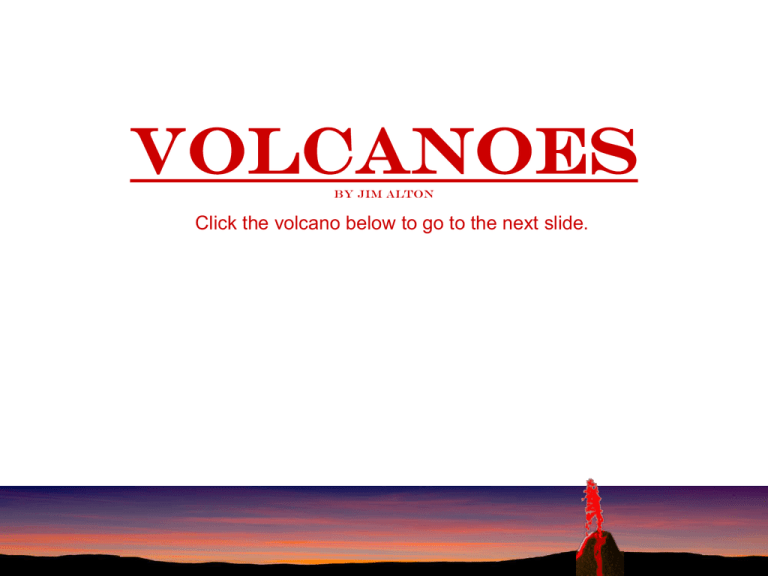
Volcanoes by Jim Alton Click the volcano below to go to the next slide. What are volcanoes? Today we will look at: • • • • Where they occur “Continental Drift” & “Plate Tectonics” Types of volcanic eruptions Historical eruptions Volcano environments • Most active volcanoes are located along, or near, the margins of the continents. • More than half en circle the Pacific Ocean. • The area in red, below, is called the "Ring of Fire." Plate-tectonics theory • Alfred Wegener first proposed “Continental Drift” Theory in early 1900’s. This theory was widely criticized. • Discovery of mid-ocean ridges gave birth to “Seafloor Spread” theory. • The demonstration below shows the drift in reverse, ending with the super-continent “Pangea”. What drives plate tectonics ? • One theory is that convection within the Earth's mantle pushes the plates, in much the same way that air heated by your body rises upward and is deflected sideways when it reaches the ceiling. • Another theory is that gravity is pulling the older, colder, and thus heavier ocean floor with more force than the newer, lighter seafloor. Divergent boundaries (Seafloor Spread) • As the two sides of the mountain move away from each other, magma wells up from the Earth's interior. • It then solidifies into rock as it is cooled by the sea, creating new ocean floor. Convergent boundaries • New crust is continually being pushed away from divergent boundaries, increasing the Earth's surface. • The ocean crust subducts, or slides under, other pieces of Earth's crust. Collisional boundaries • When two land masses meet, neither will slide under the other. • They crumple and fold. Some pieces of land are thrust over or under other pieces. The result is a mountain range. Transform boundaries • Two plates move against each other, building up tension, then releasing the tension in a sudden and often violent jerk. • This sudden jerk creates an earthquake. Hot Spots • The Hawaiian volcanoes were formed by a hot spot that remained fixed as the pacific plate moved to the north west. Island Arcs • One plate sinks into a trench. A continuous series of earthquakes is created. The plate then starts to heat up at a depth of about 75 miles. certain magmas are melted and rise toward the surface, forming volcanoes. • If the upper plate is oceanic, the volcanoes pile up until they poke through the surface of the ocean and form an elegant arc. Types of Eruptions Principal Types of Volcanoes • Cinder cone volcanoes • Composite volcanoes • Shield volcanoes Cinder cones • are the simplest type of volcano • are built from particles and blobs of congealed lava ejected from a single vent • gas-charged lava is blown violently into the air, it breaks into small fragments that solidify and fall as cinders around the vent to form a circular or oval cone. • have a bowl-shaped crater at the summit and rarely rise more than a thousand feet or so above their surroundings Composite volcanoes (stratovolcanoes) • are typically steep-sided, symmetrical cones of large dimension built of alternating layers of lava flows, volcanic ash, cinders, blocks, and bombs and may rise as much as 8,000 feet above their bases • Most have a crater at the summit which contains a central vent or a clustered group of vents Shield volcanoes • are built almost entirely of fluid lava flows • Lavas also commonly erupt from vents along fractures (rift zones) that develop on the flanks of the cone Strombolian-type eruption • huge clots of molten lava burst from the summit crater to form luminous arcs through the sky "Vulcanian"-type eruption • a dense cloud of ashladen gas explodes from the crater and rises high above the peak • Steaming ash forms a whitish cloud near the upper level of the cone "Hawaiian" eruptions • may occur along fissures or fractures that serve as linear vents • may occur at a central vent "Phreatic" (or steam-blast) eruptions • driven by explosive expanding steam resulting from cold ground or surface water coming into contact with hot rock or magma • they only blast out fragments of pre-existing solid rock from the volcanic conduit • generally weak, but can be quite violent in some cases – (Mt St. Helens) “Plinian" eruptians • Most powerful • Involve the explosive ejection of relatively viscous lava • Fast-moving deadly pyroclastic flows are common Largest eruptions Power of a Volcano • The following slides demonstrate the power of one of the better known American volcanoes. • Mount St. Helens erupted on May 18, 1980. • 57 victims were claimed in the eruption. • 4 victims were in the restricted zone. • The remaining 53 victims were in areas believed to be safe. • Some victims were as far as 13 miles away. Mount St. Helens - 1980 Before and After – Obscurity Lake Before and After – marker 393 Krakatau • Krakatau erupted in 1883, in one of the largest eruptions in recent time • The explosions were heard on Rodriguez Island, 4653 km distant • Ash fell on Singapore 840 km to the N, Cocos (Keeling) Island 1155 km to the SW, and ships as far as 6076 km WNW. Darkness covered the Sunda Straits from 11 a.m. onthe 27th until dawn the next day. • Giant waves reached heights of 40 m above sea level, devastating everything in their path and hurling ashore coral blocks weighing as much as 600 tons • At least 36,417 people were killed, most by the giant sea waves, and 165 coastal villages were destroyed • When the eruption ended only 1/3 of Krakatau, formerly 5x9 km, remained above sea level, and new islands of steaming pumice and ash lay to the north where the sea had been 36 m deep. Mount Tambora • The 1815 eruption of Tambora was the largest eruption in historic time. • About 150 cubic kilometers of ash were erupted (about 150 times more than the 1980 eruption of Mount St. Helens). • About 10,000 direct deaths were caused by bomb impacts, tephra fall, and pyroclastic flows • An estimated 82,000 were killed indirectly by the eruption by starvation, disease, and hunger. • Talcous dust was carried high into the stratosphere where it began to float around the earth. • Due to this immense cloud of dust a part of the incoming sunlight was bounced back into space. “The Year Without a Summer” • The 1815 eruption of Tambora caused the "Year without a Summer." • Daily minimum temperatures were abnormally low in the northern hemisphere from late spring to early autumn. • Famine was widespread because of crop failures. So, Are you feeling lucky? Click the volcano below to go to the next slide. Quiz Index (Click on a button to select a topic) Plate Boundary Quiz Return to homepage Volcano Quiz To PowerPoint Index Plate Boundary Quiz (Click on a button to choose a question about a boundary) Convergent Boundaries Divergent Boundaries Collisional Boundaries Transform Boundaries Return to Index Volcano Quiz (Click on a button) Largest Eruption in Prehistoric Time? Largest Eruption in Modern Time? Smallest volcano “type”? Least explosive volcano “type”? Return to Index Which is an example of a transform boundary? (Click the correct button) Coast of California West Coast of South America Himalaya Mountains Iceland Return to index Which is an example of a divergent boundary? (Click the correct button) Coast of California West Coast of South America Himalaya Mountains Iceland Return to quiz index Which is an example of a convergent boundary? (Click the correct button) Coast of California West Coast of South America Himalaya Mountains Iceland Return to quiz index Which is an example of a collisional boundary? (Click the correct button) Coast of California West Coast of South America Himalaya Mountains Iceland Return to index Wrong Answer! (Did your fingers slip?) Click the button below to try another question. Return to quiz index Fantastic!!! Way to go!!!! Click on the button below to go again! Return to quiz index What was the largest known eruption in prehistoric time? (Click on the correct button) Krakatoa Yellowstone Mt. St. Helens Vesuvius Mt. Pinatubo Tambora Return to quiz index What was the largest eruption in modern (historic) time? (Click on the correct button) Krakatoa Yellowstone Mt. St. Helens Vesuvius Mt. Pinatubo Tambora Return to quiz index Which of the below is the smallest type of volcano? (Click on the correct button) Cinder cone Shield Strombolian Composite Return to Index Which of the below is the Least explosive Volcano “Type”? (Click on the correct button) Cinder cone Shield Strombolian Composite Return to Index


